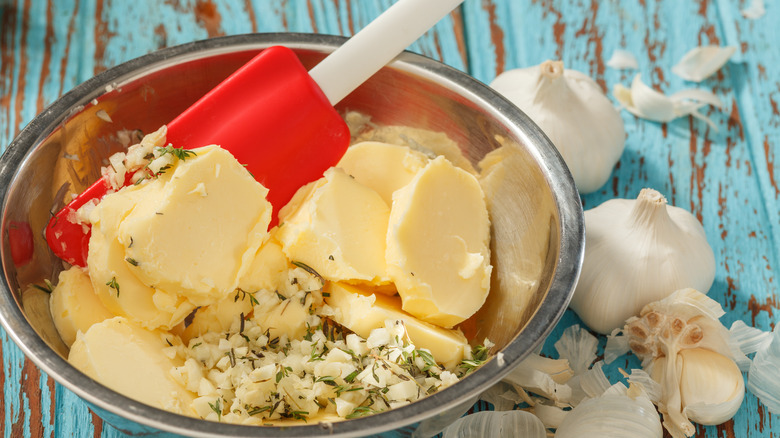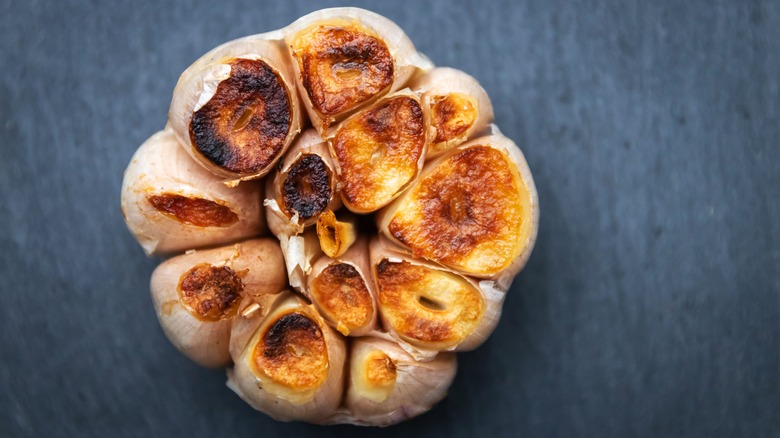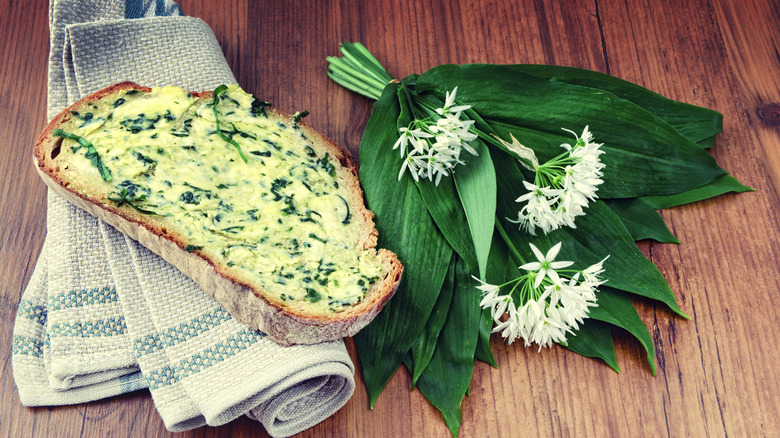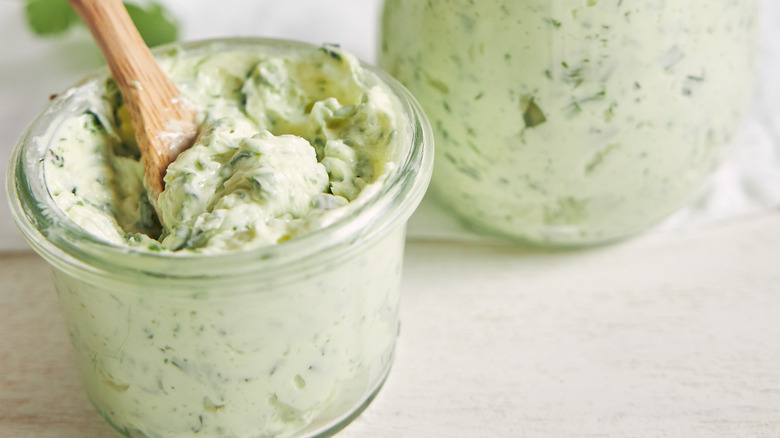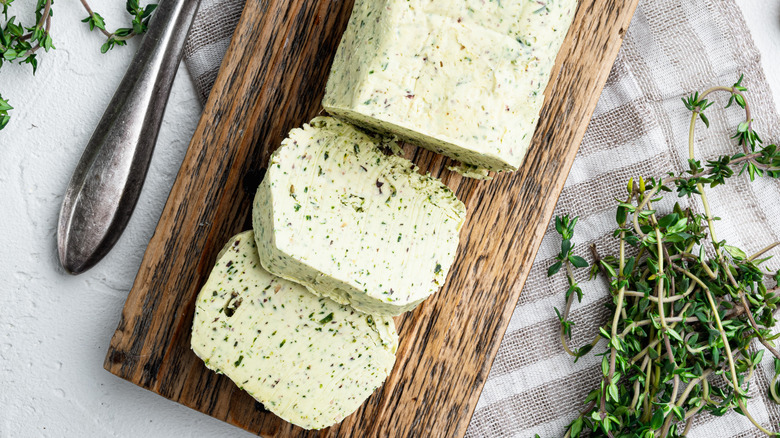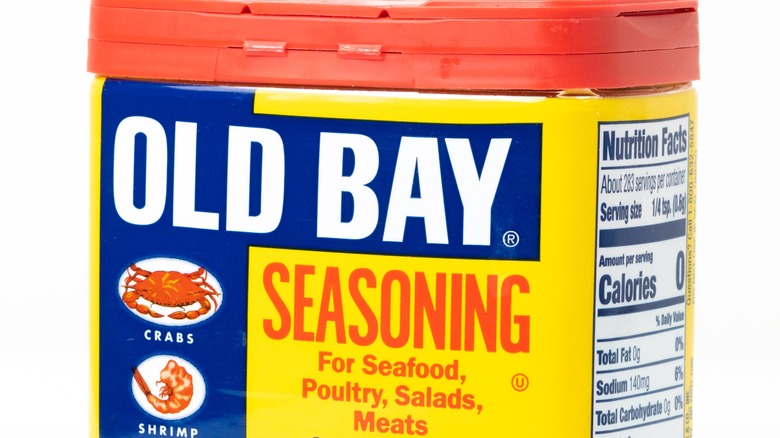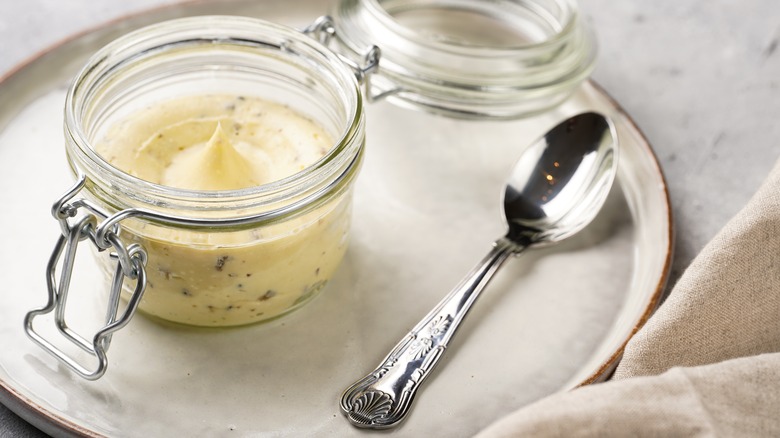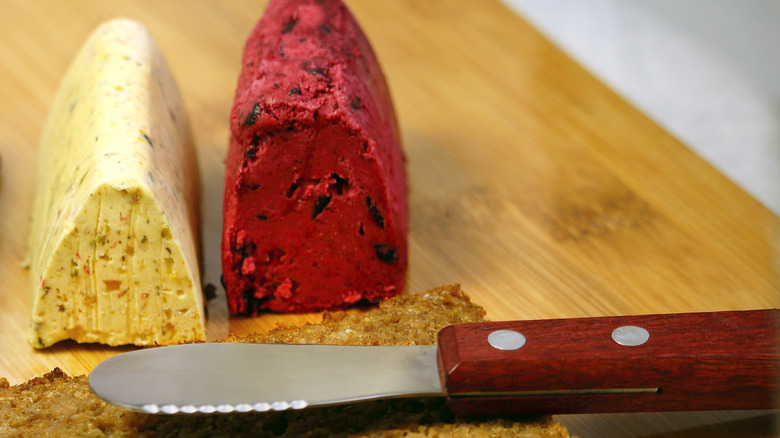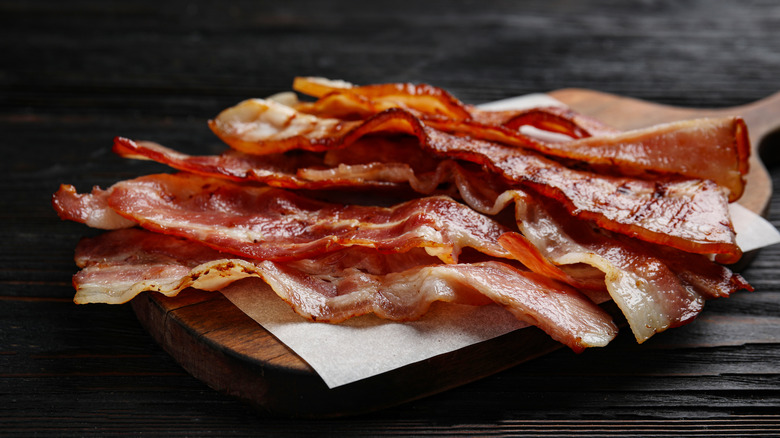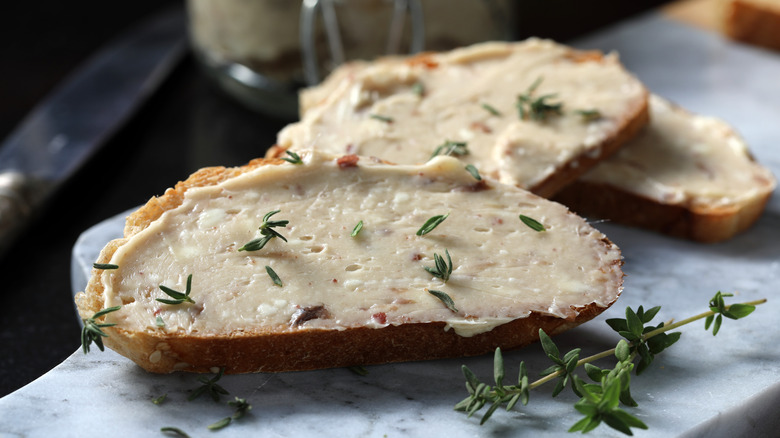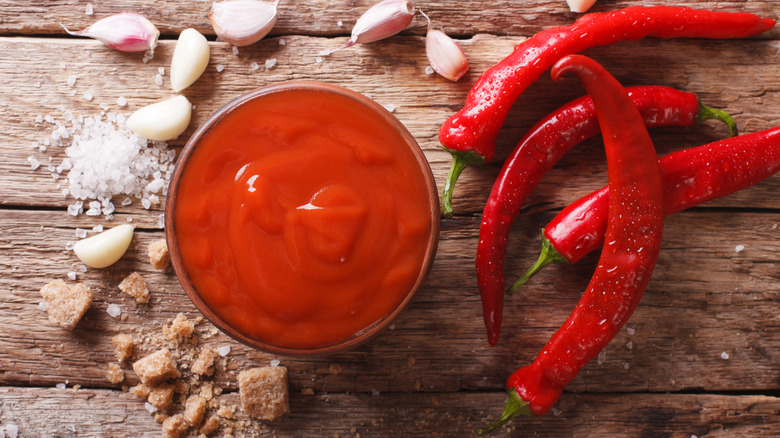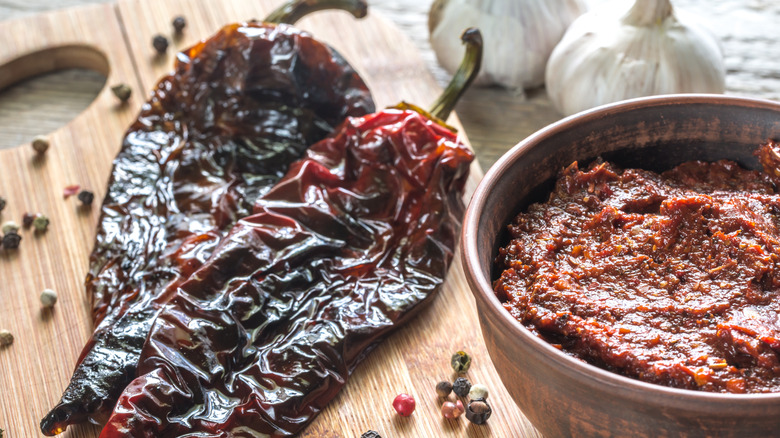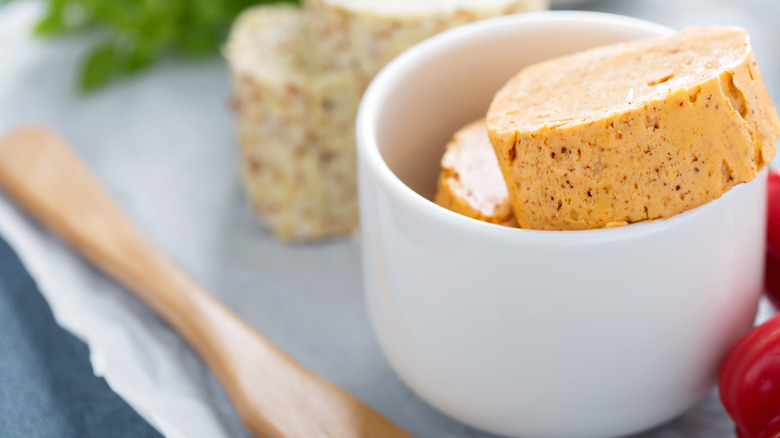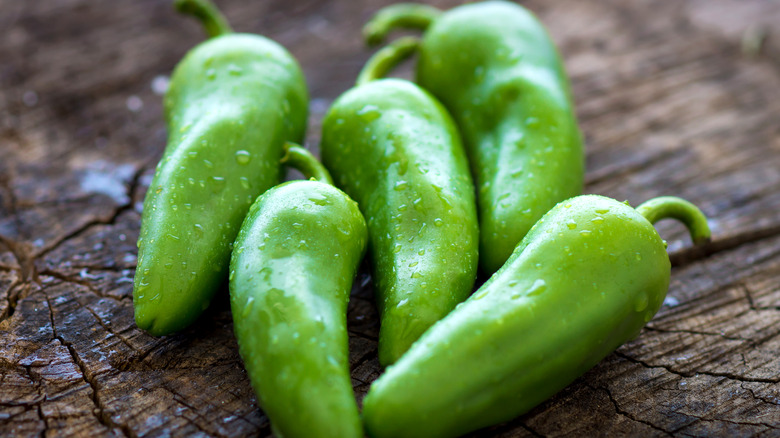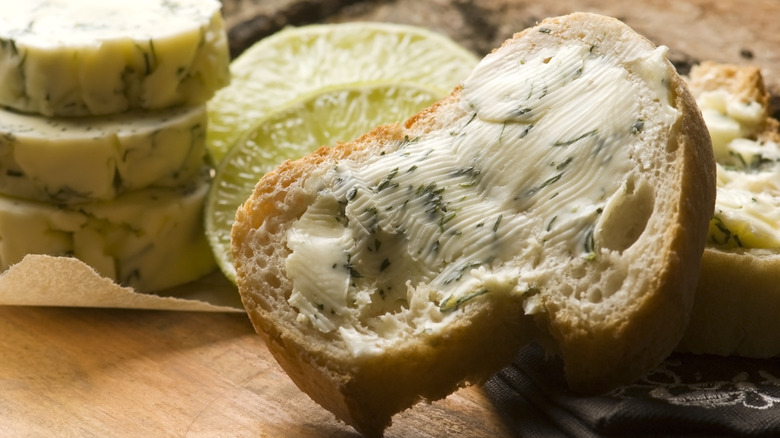14 Delicious Homemade Flavored Butters To Amp Up Your Next Dinner Party
Butter has taken on a new life lately, thanks to the recent TikTok-born trend of serving butter boards at gatherings. Popularized by food influencer Justine Doiron, a butter board is simply a cutting board or other platter covered in a layer of softened butter and topped with an artistic array of garnishes for flavor and visual appeal that you can swipe a cracker or piece of bread through. It's a whole new butter delivery system, and it's taken dinner parties by storm. However, a butter board is not the only way to integrate creamy, delicious butter into your party menu.
Flavored butters, also known as compound butters, are simple to make and can add bursts of richness and flavor to a multitude of dishes. To make a compound butter, you start with butter — salted or unsalted, it's your choice — softened at room temperature. Mix in your flavoring ingredients, either by hand or with a mixer, then shape it any way you like and chill until ready to use. An elegantly presented flavored butter, served as a butter board or as part of your main menu, is sure to liven up any dinner party. Here are some ideas to get your flavored butter game started.
Roasted garlic butter
If you're a garlic enthusiast, there's no aroma in the world more enticing than the scent of it roasting in the oven. While raw garlic has a pungent, sharp scent and flavor, those same cloves develop a rich, mellow character when roasted. This is because there's a compound in garlic called allicin which is what gives it that harsh bite, and that compound is broken down when heated. What's left are tender cloves with a deeply concentrated flavor and a touch of sweetness. The texture of roasted garlic is already buttery on its own, so mixing it with butter makes an extra sumptuous spread.
Roasted garlic butter has one obvious, perfect use — and that's garlic bread. Replace plain butter with roasted garlic butter in any garlic bread recipe for a deeper, more layered flavor. But that's not all it's good for. Roasted garlic butter can add rich garlicky goodness to any dish on your dinner table, so add a dollop of it on top of steak, potatoes, and vegetables like green beans, broccoli, or corn for an instant flavor boost.
Allium butter
The genus known as allium contains some of the most widely used plants in cooking, including onions, shallots, chives, leeks, and garlic. While they are all related, each of these plants grows in many different varieties which have their own distinctive flavors and textures. Any combination of them, raw or cooked or both, can be added to butter to create a flavorful savory spread that has many potential uses.
Minced raw shallots, onions, and garlic can be combined with butter to make a sharp, intensely pungent, and flavorful butter when you want something with a real kick. Put a dollop atop a steak or burger and let the flavors melt into the meat. For a bright, fresh, and more subtle allium flavor, chives and scallions can be chopped and mixed with butter to make a delicious spread for bread, or melted over spring vegetables like asparagus. Cooked leeks develop a sweet, buttery flavor, making them the perfect addition to compound butter. Leeks and potatoes have a natural affinity for one another, making leek butter a fantastic topping for mashed, baked, or roasted spuds.
Less common alliums make great flavoring additions to butter, but may be harder to track down. Keep your eyes open for ramps, ramsons, wild leeks, garlic chives, and other unusual varieties that may be foraged or found at farmer's markets to create butters with unique allium flavors.
Pesto butter
While there are many different varieties of pesto, the one you're most likely familiar with is pesto alla Genovese. This classic Italian recipe calls for basil, pine nuts, garlic, grated cheese, olive oil, and a touch of salt, traditionally crushed with a mortar and pestle to create a textured sauce. Vibrant green and brimming with fresh basil flavor, this light, brightly herbaceous substance can be given a luxurious new identity when mixed with butter.
Pesto butter can stand in for regular pesto in any of your favorite recipes when you want to add a little more richness and creaminess. The flavored butter will add a silky, unctuous texture to pesto pasta and risotto. Add a dollop on top of fried or scrambled eggs for a nice herby kick. Of course, it makes a delightfully summery spread on bread. Just keep in mind that fresh basil doesn't take well to too much heat, so pesto butter is best when added towards the end or after the cooking process.
Herbes de Provence butter
The ingredients that constitute herbes de Provence, an herbal mixture that originated in southern France, are not set in stone. So what's fun about making herbes de Provence butter is that you can be creative and make your own unique blend that suits your taste. While the term usually refers to a mixture of dried herbs, the same fresh herbs can also be used for a brighter, zippier flavored butter.
Herbs typical in the blend include thyme, rosemary, tarragon, oregano, marjoram, and savory. Other herbs like basil, chervil, and sage also sometimes make an appearance, as well as fennel seed. Lavender, which is ubiquitous throughout the Provence region, can also be added to give the mix a lifted floral quality. While pre-made mixes of herbes de Provence can be purchased, making your own ensures you can customize it to your tastes and needs.
Herbes de Provence butter is a fantastic accompaniment to roasted chicken or fish, spread on crusty French bread, or tossed with roasted tomatoes and zucchini. Swirl it into stews and soups to punch up the herbal flavors, like in this beef daube Provencal. It's a great option for a butter board, particularly when garnished with fresh sprigs of herbs and edible flowers.
Old Bay butter
If you've ever enjoyed seafood along the Eastern Seaboard, particularly around Maryland, you've most likely experienced the delicious and enigmatic seasoning mix known as Old Bay. The exact recipe today is a secret, although the original which was invented around 1940 included salt and pepper, cardamom and cloves, laurel leaves, mustard, ginger, and paprika. McCormick, which now produces the blend, lists only celery salt, red and black pepper, and paprika on its label — the rest of the ingredients are hidden behind the word "spices." Warm autumnal ingredients like cinnamon, nutmeg, mace, and allspice often show up in copycat recipes around the web, as intrepid fans attempt to recreate the iconic blend.
You can't do much better than Old Bay flavored butter when it comes to shellfish and other seafood. Toss grilled shrimp with a generous serving of Old Bay butter to bring out the crustacean's natural richness and sweetness. Spread Old Bay butter on bread prior to griddling when making crab or lobster rolls for a punch of extra flavor. It's the ideal topping for grilled oysters. And you can easily amp up seafood stews and bisques by stirring in a pat of Old Bay butter just before serving.
Truffle butter
Truffles are one of the culinary world's rarest and most treasured ingredients. These tubers come in many different varieties, but they all share certain qualities, like intense fragrance and deep earthy flavor. Black truffles tend to exhibit a powerful earthiness and loads of umami, while white truffles are more delicate, often with a high-toned onion-like pungency to their scent. If you're lucky enough to get your hands on fresh truffles of either type, making truffle butter is an excellent way to incorporate their distinctive flavors and aromas into your dishes.
There are countless uses for truffle butter. Melt it atop a steak — preferably a high-end cut of meat, like wagyu filet mignon or a dry-aged, grass-fed ribeye. Truffle butter mixed into pommes aligot creates an even more decadent version of the classic French potato dish. Stir into risotto or toss with pasta to make a simple and sublime starch dish. For an exceptionally elegant start to a dinner party, serve a truffle butter board, garnished with roasted wild mushrooms and shaved pecorino or Parmigiano cheese for extra umami.
Wine butter
An easy way to add a sophisticated, elegant touch to your dinner party is with wine butter. Any type of wine can be used to infuse butter with its unique flavors and aromatics, as well as color. While red wine butter is the most common, you can also use white, rose, and even fortified and dessert wines to add complexity to your butter.
A good rule of thumb to follow: whatever food you would pair with a particular wine will also go well with its flavored butter. For example, if you have a rich, full-bodied cab, a butter infused with that wine will go perfectly with steak or prime rib. A zesty white wine that you would drink with seafood, like a sauvignon blanc or an albariño, will make a great complementary butter for fish and shellfish.
You can add the wine directly to your butter as-is, but keep in mind it will retain its alcoholic kick. For more intense flavor and to cook off some of the wine's booziness, reduce the wine first by cooking it over low heat until it's concentrated. And as with all cooking, the quality of the wine will show through, so never make flavored butter with a wine you wouldn't happily drink.
Bacon butter
Bacon makes everything better, including butter. And while bacon compound butter is a no-brainer for a brunch party, it makes a great dinner party accompaniment, too. Bacon butter can top steak, baked or mashed potatoes, roasted vegetables like asparagus — anything that can benefit from a rich smoky, savory punch of flavor. You can also rub it under the skin of poultry such as chicken, turkey, and duck before cooking to saturate the poultry meat with buttery bacon goodness.
Bacon butter can be made in a few ways, depending on what kind of texture you prefer. The first step is cooking the bacon until it's crispy and reserving the fat. Mixing the saved bacon fat in with the butter is what infuses the flavor all the way through, so don't forget this step. Then you can decide if you want to pulverize the bacon or crumble or chop it into larger pieces. Combine the butter, fat, and bacon pieces, and your bacon butter is done.
Bacon butter can be garnished with tomato jam and fresh greens like arugula to create a B.L.T. butter board. Guanciale or pancetta can be used in place of bacon, and the butter topped with pecorino cheese and freshly cracked black pepper to create a butter board that's inspired by carbonara, the classic Roman pasta dish.
Anchovy butter
Anchovies and butter are a match made in heaven: richness and creaminess meet salt and umami to create a flavor bomb that adds boldness and intensity to everything, from pasta to fresh radishes to filet mignon. Anchovy butter is a simple combination of drained anchovies, the highest quality you can find, and unsalted butter so the mixture isn't overly seasoned, mixed together by hand or using a food processor. Once you try it, you may never go back to anchovy-less butter again.
Chopping the anchovies and mixing them in by hand keeps the butter rustic, and will give you pops of briny anchovy flavor. If you like a smoother, sleeker character, letting a machine do the work produces a silkier version. Either way, the flavored butter can be used to top all kinds of meat and fish, shellfish, starches, and vegetables. Garlic makes a great addition to anchovy butter, giving it a bagna cauda flavor that's perfect on warm, crusty bread.
Sriracha butter
Sriracha, the tangy, fiery garlic chili sauce that's become a worldwide sensation, makes a great ingredient in flavored butter. Dairy naturally mellows out the heat of peppers, so a Sriracha butter will be a little milder than the straight sauce, allowing you to use it with exuberance rather than restraint.
Sriracha butter is just as versatile as its spicy main ingredient. It adds a zesty kick to meat, seafood, and vegetables when melted on top. Use it as a spread on sandwich bread, buns, and rolls before you griddle them to add a smack of heat to burgers, grilled cheese, hot dogs, and sausages. Even softened and enriched by butter, Sriracha's piquancy and vinegar tang works as a foil for opulently fatty dishes like macaroni and cheese. Tossing it with anything breaded and fried, like chicken or shrimp, is an easy way to amp up their flavor without overwhelming them with too much heat.
Chipotle lime butter
Chipotle peppers in adobo sauce are a deliciously smoky, deeply flavored ingredient to add to butter, and a dash of lime adds just the right zing. Butter lessens the hotter elements of the chipotles, which are dried and smoked versions of jalapeño peppers, and adds a sweet creaminess to complement the tanginess of the tomato and vinegar-based adobo sauce. Together, these ingredients make a tasty combination to use on Mexican, Latin, and Southwestern-style dishes.
Chipotle lime butter is made to be spread over corn on the cob, its bold flavors melting into the nooks and crannies between the kernels — and it's great on cornbread, too. The blend of warm, tangy, spicy, and sweet adds all of these dimensions to grilled meats and seafood. A spoonful of chipotle lime butter stirred into plain rice is an easy way to liven up its flavor before serving it as a side dish with the rest of your dinner party menu.
Calabrian chili butter
Calabrian chilis hail from Southern Italy and are known for their pronounced yet moderate heat and fruity flavor. They're often sold in the form of oils and pastes so they can be easily added to foods during cooking. Whether you find them fresh or in another form, Calabrian chilis are a wonderful ingredient to use to create a bright, piquant, and rich flavored butter that has a number of tasty uses.
Pasta is a natural pairing with Calabrian chili butter, which can be mixed into tomato, meat, or even cream-based sauces, or used on its own simply tossed with noodles. The butter adds a simmering Mediterranean heat when melted on top of meat and fish. Because Calabrian chilis' heat is not too blazing, you can pair it with milder-tasting ingredients like chicken and it won't be out of balance. A little of the flavorful butter mixed into broth will add just enough richness and heat to complement braised shellfish like clams and mussels.
Jalapeño agave butter
Combine the bite of fresh jalapeño peppers with the rich creaminess of butter, and a hint of sweetness from agave syrup, and you've got a compound butter that will surely invigorate your dinner party menu. Depending on how much heat you want your butter to convey, you can load it up with plenty of jalapeños, seeds and all, or you can use a light hand so the butter is sparsely flecked with the minced or chopped peppers. Keep in mind that the addition of agave syrup will moderate the peppers' heat, as will the butter, so you can use a bit more than you might normally be comfortable with.
If you're serving Mexican or other Central American cuisine, jalapeño agave butter is a must. Spread jalapeño agave butter on tortillas or cornbread. It's great on corn on the cob. The combination of sweetness and heat works especially well with chicken and pork. A jalapeño agave butter board is a fun way to kick off a dinner party, particularly when paired with cocktails made from agave-based spirits, like tequila, sotol, and mezcal. Use Tajin, a Mexican seasoning blend, to rim your drinks and garnish your butter board for an extra spicy, salty burst of flavor.
Citrus butter
Extremely versatile and simple to make, a compound butter with citrus can be a game-changer when it comes to adding flavor to food. Countless dishes can benefit from a bright hit of zesty citrus butter, from seafood to vegetables to red meat, like this ribeye with pepita-lime butter. And the wide variety of citrus fruits means you can create an infinite number of flavored butters, featuring one type of citrus or a combination of several. Using the fruits' juice, flesh, or zest gives the butter different flavors, aromas, and textures, as well.
There are your basic lemons, limes, oranges, and grapefruits, which can be zested, squeezed, and puréed and then added to butter. But don't shy away from more unusual citrus fruits that can result in sublime compound butters with unique flavors. Fruits like Meyer lemon, yuzu, and bergamot are wonderfully fragrant with hints of floral notes, creating compound butters with intoxicating perfumes. Sweet, tart, and tiny, kumquats can be used whole, skins and all, and used to make a bright and tangy butter. The juice and flesh of blood oranges add a stunning hue to butter, from maroon to crimson to deep pink, making it an eye-catching choice for a butter board.
